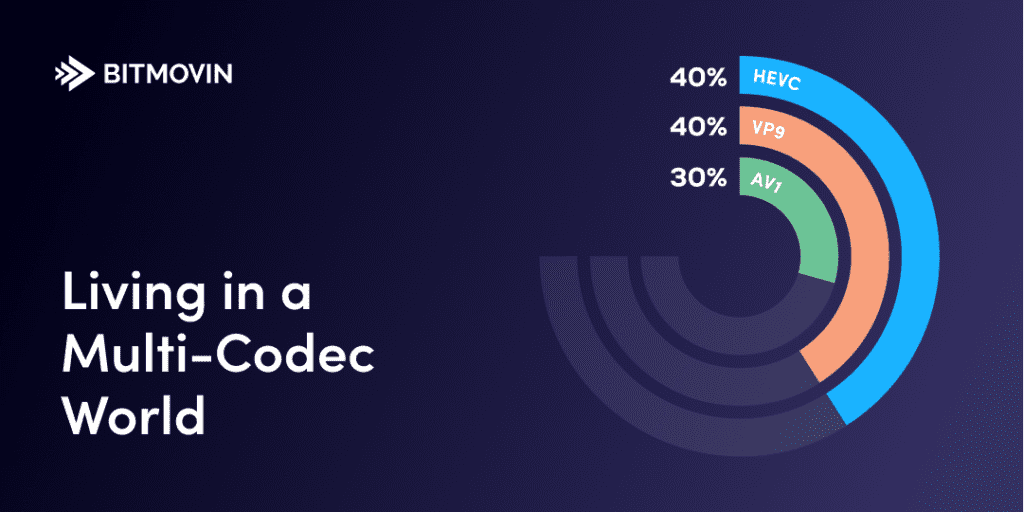Multi-Codec World is here and now
Two years ago we published the blog post “Get ready for a multi-codec world”. With the official launch of H.266 (VVC) and the progression of future codecs like AV1 and VP9, it’s a good time to revisit the state of the multi-codec world, and why it’s important to your streaming workflows.
In the last decade, the tech industry has rallied around one codec for streaming video files over the internet: MPEG’s AVC/H.264. Now the market is moving toward a new generation of video codecs that offer 30% to 40% better compression than H.264. Is your organization ready to experience the world of multi-codec implementations?
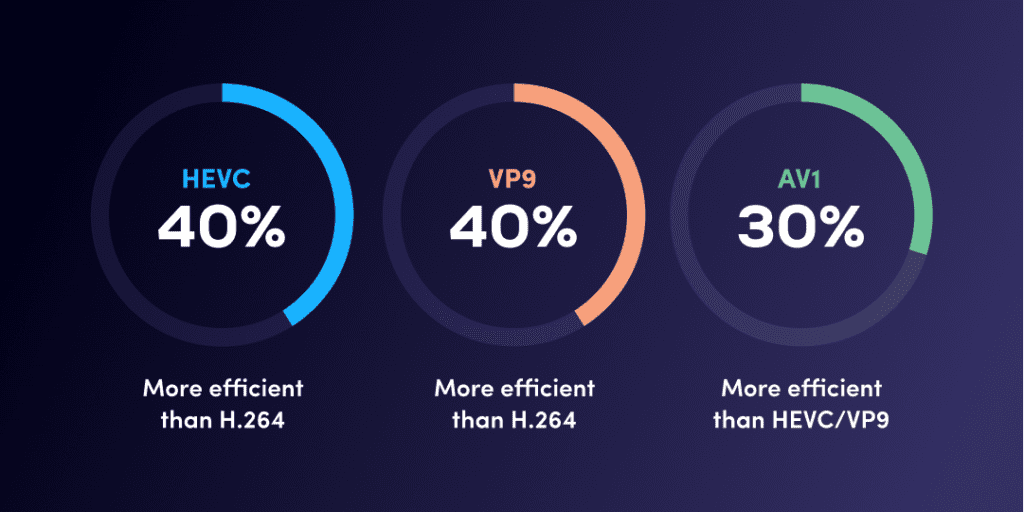
Adopting the new generation compression technology is important because compressing video files means you can send higher-quality video over the same network infrastructure, for a richer, more compelling viewer experience and reduce delivery costs for popular content.
According to Sandvine’s Global Internet Report 2019, video streaming accounts for over 60% (3% increase from 2018) of all global traffic. However, Sandvine posits that this number is expected to rise significantly by the end of 2020 with an increase of 4K and 8K quality content. Some researchers say that it can even jump up to a staggering 70%.
Based on a similar report from Statista, broken out at the country level – most regions are seeing well over 60% of internet consumption attributed to digital video consumption – with the US clocking in an average of 85%.
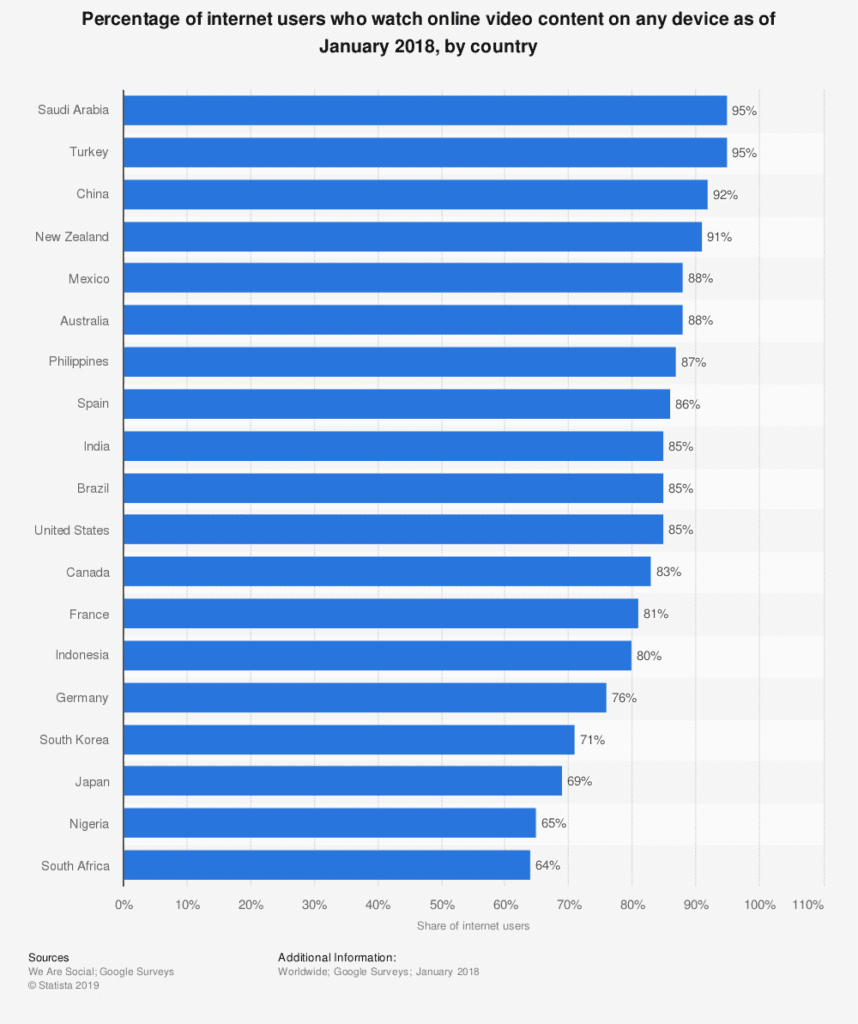
In addition, according to Cisco research, as of March 2020, 493 million global consumers own a connected 4K quality TV, by 2023, this number is projected to exceed 831 million – a staggering 66% of all connected TVs. That powerful market dynamic is driving the adoption of new technologies to encode and decode video so it can travel more efficiently over the web. But so far, there is no clear winner in the high-efficiency codec space.

More Devices = More Codecs
With over 431 million global consumers owning 4K connected TV by 2023 and up to 70% of all global internet traffic shifting to video content, it’s more important than ever to implement a multi-codec approach to hit as much of your target audience as possible. According to our 2019 Video Developer Report, there is a huge growth in all modern codecs (see graph below). The bar is an indicator of survey respondents who already use a certain codec and the red line indicates how many additional respondents planned to implement the codecs in the coming year.
Let us know which codecs you use and plan to use in the coming year in our 4th Annual Video Developer Survey here
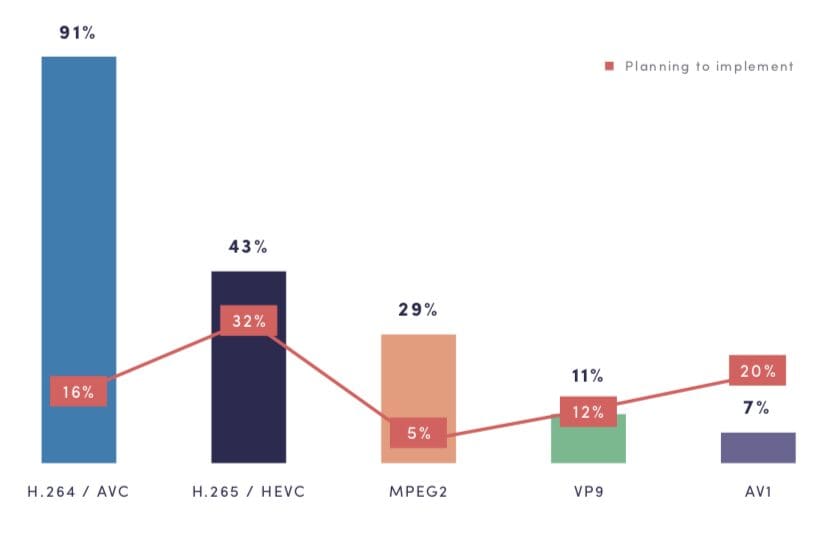
At first look, the logical approach for companies that support streaming video with H.264 today is to stay the course and to add the next-generation MPEG video codec, HEVC/H.265 to their compression delivery suite. It’s important to note that in mid-2020, another next-gen codec had been finalized to support 4K and 8K streaming devices, Versatile Video Coding (VVC)/H.266.
In terms of compression, H.265 is a significant improvement over H.264 — roughly 50% more efficient. That puts it on par with Google’s VP9 codec, which does not charge licensing fees, but also does not offer full device reach (yet). Then there’s a third player, AV1, which is an open-source codec from AOMedia. Continuing the initial work on VP10, AV1 boasts 70% better compression than H.264. That’s caught a lot of people’s attention, even though there are still some questions around AV1 for many monetization workflows The VVC/H.266 codec promises to reduce bitrate costs by a full 50% over its predecessor, HEVC. (For more info download our AV1 Datasheet)
Managing the codec choices
Today, browser and device makers are fragmented in their support for these new codecs. Apple’s Safari browser supports HEVC/H.265, but not VP9. Google and Firefox are behind VP9 and AV1, and steering clear of HEVC/H.265. So how can savvy businesses get the benefits of more efficient compression and still reach users on all platforms?
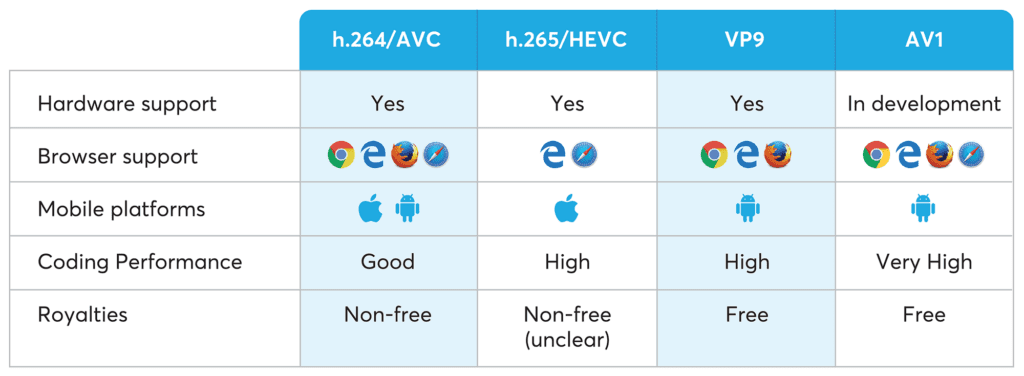
Most companies will need to take a more nuanced and pragmatic approach to adopt and support new media codecs. Right now, we have as many as four different high-efficiency video codecs to choose from (including LCEVC/MPEG-5), with more ready for compressing ultra-high-definition video and virtual reality media.
Hybrid and Multi-Codec Approach
The way forward is a hybrid multi-codec approach. Companies will need to continue supporting H.264 to ensure interoperability with every device. At the same time, there’s an opportunity to build out support for HEVC, VP9, AV1, and VVC that deliver higher quality video, for a differentiated service offering.
Implementing this approach requires a clear set of criteria for business goals. For instance:
- Who is the target audience?
- What kind of content are you optimizing for? Is it scheduled, like a sports event? Or is it unexpected, like breaking news?
- How high is expected demand?
- What platforms are watchers most likely to connect on?
- How important is it that this content is high-quality?
- Do you need to support HDR/Dolby Vision content?
- Do you need to support UHD/4K content?
- How important are download times? What are the acceptable bandwidth costs?
- How many platforms do you need to support? Do they include newer web-enabled devices like set-top boxes and web TVs?
These questions are important when it comes to carefully evaluating how a new codec can enhance your business opportunities — and when it’s not worth the overhead. In the case of HDR and UHD/4K content, next-gen codecs are required, as h.264 will be impractical and incompatible.
When to invest in better compression
Encoding video content in more than one codec is costly. You’re investing CPU cycles in the encoding work itself, including the costs of power, cooling, and rack space. You’re also paying to store two or more versions of the same file in your data center.
On the plus side, once you encode in a high-efficiency format, you’ve got a smaller file to store, that can stream more quickly to a lot of people and incur lower bandwidth costs. So if demand for that particular asset is high enough, it’s possible to recoup your encoding costs — and deliver a higher quality product than the competition. If a video goes viral, and you can reach the right platforms or user groups with higher quality video, this investment can pay off handsomely.
Building a smart encoding model can help businesses find an optimal solution for each use case. Now – adopting both the VP9 and HEVC would enable you to deliver advanced compression to roughly 98% of the browser users in the US.

Here are some sample use cases.
- An online newspaper has a breaking story that it expects to have broad appeal. The publisher encodes its exclusive footage in HEVC/H.265 and VP9 in addition to H.264, to offset the double hit on encoding costs with lower bandwidth fees, and delivering crisp, clear visuals to mobile phones and laptops.
- A video-on-demand company is the first to get the rights to stream a blockbuster movie in high definition (HD). It anticipates heavy demand in its target market, Asia, where most viewers have web-enabled HD TVs. It encodes the file in H.264, HEVC/H.265, and VP9, to deliver crisp, clear visuals on the big screens.
- A large social media platform has some fast-trending videos and the rest of the footage that only gets played a few dozen times. The video engineers encode the top 20% of the files into HEVC/H.265 and VP9, to improve quality and speed download times for millions of trending content views, and the rest in the good-enough catch-all H.264.
Have a look at this blog post for a more technical explanation of multi-codec streaming.
Components of a smart encoding model
To successfully implement a smart encoding model, companies need tools and information to help them make key decisions, often on the fly. These include:
- An analytics platform that can show user attributes, such as type of device and connection
- Fast encoding tool to stay ahead of user demands
- Video player that supports a range of codecs
These components can help guide your company through the steps of new decision-making processes.
Gather information
Analytics can help companies determine which video assets to re-encode in a high-efficiency codec — especially helpful for mobile devices, web TVs, and set-top boxes. Once you have a clear picture of your audiences, platforms, and demographics, it’s possible to optimize those experiences while containing costs.
Capture opportunities
Getting higher quality videos to the right audience and platforms at the right time is a new market imperative. Popular content travels quickly; make sure your encoding tool can keep up. Decades ago, it took hours to encode a 30-minute video. Now, the fastest encoding tools work at speeds of 100:1, meaning, a 100-minute video can be encoded in one minute. Faster-than-real-time speeds means that your business can respond quickly to viewers’ interests in a certain media asset — and stay flexible if you want to re-encode for additional platforms on the fly.
Reach every user
Having your content supported all along the streaming pipeline, from encoding media files to play out in a browser. You can simplify this process by standardizing on a video player that supports the full range of codec options available today and is able to identify the user’s device and browser to serve the appropriate content.
Today’s technologies are getting more complex — and more powerful. If you’re considering what high-quality video experiences can bring to your user base, it’s a good time to explore the options. As current demand shows, video has a particularly bright future on the web. What’s next? Equally steep growth curves for emerging technologies like virtual, augmented, and mixed reality, which promises to bring even more compelling educational and entertainment experiences to the web, for distribution across platforms, cultures, and continents.
At Bitmovin, we solve complex video problems, so your team can focus on building your business. As a leading provider of video infrastructure for online media companies around the world, the Bitmovin API offers the support to scale quickly and know it will work.
Have you moved into the multi-codec world yet?

